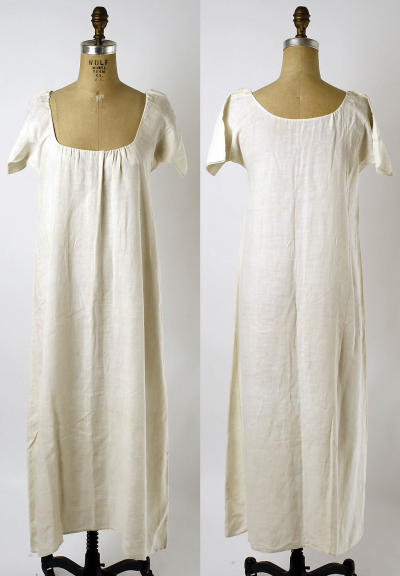
Working Women’s Clothes, 1810-1820
By Kieran Hazzard
This article is intended to provide a quick guide to the clothes worn by soldiers' wives and female camp followers during the Napoleonic Wars. As such, it provides details on the generic working women’s clothing of the time and how to approach recreating them for a living history impression.
Shifts
Though the more risqué among the elite of Paris and London may have abandoned their shifts (and even stays) for diaphanous muslin petticoats, such trends did not extend beyond the very few. The basic shift pattern remains largely unchanged from 18th century examples, however, if anything, by the early 19th century the pattern had become simpler. Necklines became squarer and adjusted by drawstrings, while the body became narrower. Sleeves remained above the elbow, with the length suited to the season or gown worn over the top. Though cotton had taken over for almost all other garments, white linen was still much preferred for underclothes. The pattern provided by Kannik’s Korner, for a Woman's Shift, 1790-1820 is a good choice for anyone in need of a new one.
Neckerchiefs
An indispensable item during the day in order to not be regarded as that most despised thing, a ‘loose woman’. Those for everyday wear would be made from squares of muslin or cotton, measuring between 35”-45” and folded or cut into a triangle; coming in various patterns and colours. Plain, floral prints or checks, were common, though if outer garments were patterned they tended to be plain.
For Sundays and other important occasions, they were more commonly ivory muslin, perhaps with a little embroidery, as seen in this elaborate muslin, worn by Empress Josephine. A Plainer example is available online from Historika.

Stays
Due to their private nature, numerous variations and the dramatic changes in high fashion it is difficult to judge what exactly a working woman wore under her gown with any certainty.
That said, judging from the silhouettes in contemporary images and the physical nature of their everyday lives it is unlikely that the full length ‘corset’ with wooden busk seen by 1810 (right) was common among ordinary women. Similar a regency lady’s ‘short stays’ do not provide the shaping for gowns with a more natural waistline, which remained popular with working women. The ideal solution therefore appears to be those sets of stays usually associated with the 1780s (left).
That’s said, it also appears that a woman owned several pairs of stays, suited to certain tasks or outfits. One contemporary book on clothing the poor suggests 3 sets, with slight variations. Therefore, it is likely that during the week women wore the ‘easier’ older style stays, while on a Sunday, where she might wear a more fashionable cotton empire-line dress, the full length regency corset was required.
As stays are expensive it may be best to make do with what you already have, and as bedgowns require no specific corsetry this might prove the best option. For those after a new sets of stays there are several commercial corset markers, though Historika make a beautiful and highly accurate example.
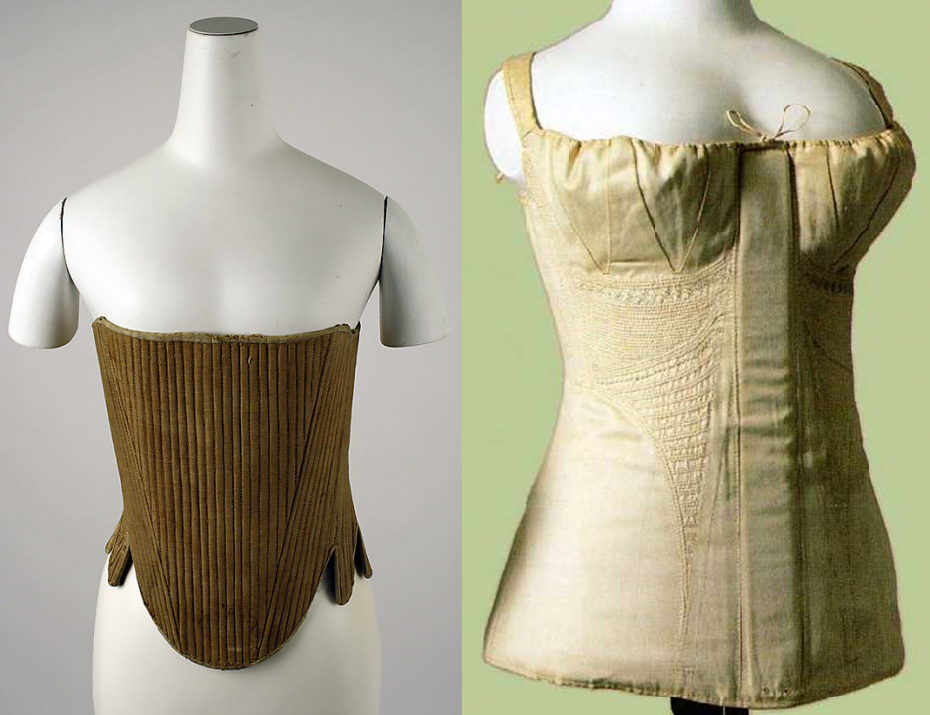
Stockings and Pockets
Simple knee length cotton knit stockings are widely available from the usual US based sutlers, such as Jas. Townsend and GG Godwin. It terms of colours, plain white, red, tan and blue were the most common, though several images also show women in vertical striped stockings of white and another colour.
Pockets worn on strings round the waist and under the outer petticoat were the common way for a woman to carry around her affects. They were as this example shows, often highly decorated by their owners. These can also be cheaply purchased from traders and then decorated as a living history project.

Petticoats
In order to emphasize waist and hips several layers of petticoats were worn. A minimum of 1, possible up to 3, plain white cotton or muslin petticoats would be worn dependant on the weather, task at hand and personal taste. These would have been closely gathered at the top and possibly flounced. On top of which would have been a plain cotton petticoat, seen in a variety of colours. In terms of pattern, they are incredibly simple; requiring only a large amount of fabric, gathered on a draw string with slits in the sides to access the pockets; hems sitting just above the ankles.
Footwear
Black leather ankle boots or flat shoes (laced or buckled) appear as standard wear for all working women, except in mills where Lancashire clogs are commonplace.
Short gaiters are also occasionally seen on women working in the fields; made in either cotton twill or wool of dark colours (brown or black most common).
Gowns
For certain occupations such as women in retail or service and for most women’s Sunday best, the cotton empire-line dress was commonly worn, particularly by younger women. So much so that several ‘lady’ authors writing in the 1810s complained of the levelling effect of cheaply available muslin gowns. At Peterloo, where a political statement was made by the wearing of white gowns, the clean and fashionable nature of the women’s clothing was noted by observers. It is therefore probable that a woman owned at least one empire-line dress, made from either white muslin or the cotton prints being churned out in Manchester. Despite the upper class protestations, working women’s empire line dresses would have had fewer embellishments and cheaper material than the day dresses of their social superiors, and a casual passer-by would have easily spotted the difference.

If your impression best suits an empire line dress then the best option is to is to go for a bib-front dress, as these were worn from at least 1800 onwards, require less fitting, and close using pins, mirroring older styles of female dress. One of the better patterns is available from Laughing Moon, No. 126, which provides a number of options, though option A is probably best, though with sleeves shortened. In terms of material, cottons are the order of the day: plain, stripes, checks and floral prints are all common, though make sure the latter are period correct. William Booth have some well documented and beautiful cotton prints.
For the majority, however, there were two major types of gown worn by working women; the bedgown and the open-robe/gown (Robe à l’Anglaise à la polonaise). The open-gown had a fitted bodice and elbow length sleeves, with the split skirt being worn either down or hitched up (tucked into petticoats or using loops and buttons sewn into the garment) as shown.

Such gowns were popular with town folk and country women whose work was mainly contained to the house, such as spinners, or the streets, such as pedlars. Though its use lingered on in the country much longer than the town, with the early 1820s marking its last hurrah.
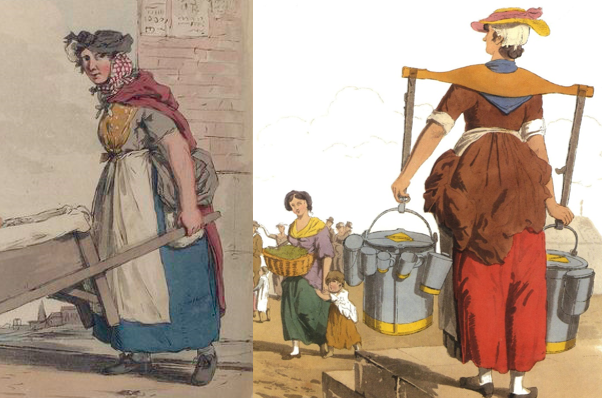
Bedgowns were a much simpler and looser garment, suitable for work in the fields, tasks requiring much bending and lifting, or other occupations which required a great deal of time outdoors in all weather. They are typically long sleeved and thigh length, held together at the waist by an apron or tie. Younger women wishing to emulate the fashionable high waists of the time even when out in the fields or factory would often tie their apron strings below their bust in order to achieve an empire line whilst still wearing a bedgown.

Patterns for both gowns are widely available, a good simple example of a bedgown is available from JP Ryan, or a more ‘fancy’ version from Kannik’s Korner. As for an open-gown, JP Ryan’s pattern for a Robe à l’Anglaise is the most accurate I’ve seen. It terms of material, cotton predominates once again due to its cost and versatility, with gowns coming in floral prints, checks, stripes and plain cloths, of many colours.

Hats
Whilst indoors, and particularly among the better sort of working women, the various styles of ‘mob cap’ made ubiquitous by film and TV, were common, out of doors this was not the case. The reality being much more varied and interesting. The pictures above give an indication of the styles available, including examples of straw bergère (shepherdess) hats. Much more common by the late 1810s were the straw bonnet or short rounded top hat made of felt as seen in the examples below.
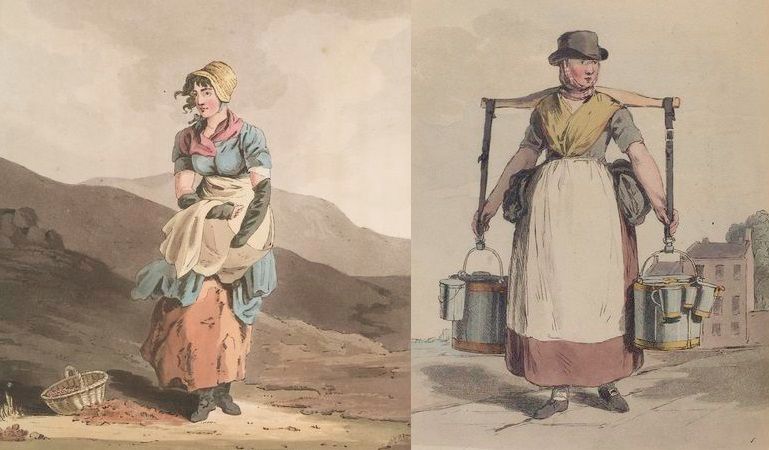
Straw bonnets and bergères are widely available to purchase on the internet, with good cheap examples available from Austentation, who provide made-up or blanks for you to customise with your own ribbons (remember to use grosgrain not modern silk/satin ribbon). Finding a suitable top hat is a little tricky; though there are many suppliers of affordable short, straight sided, felt top hats for men on eBay, the best option, ladies dressage top hats, tend to be a little pricey, so it’s worth shopping around to the right style and price (aim for something preferably no higher than a 5” un-flared crown).
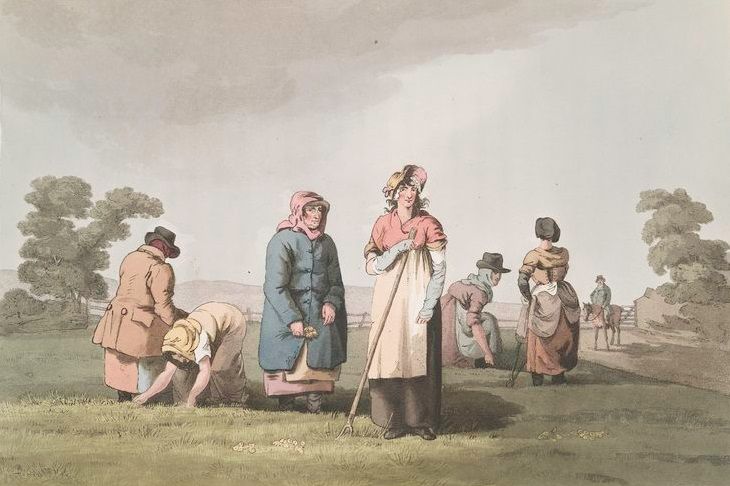
Cold Weather Clothing
During the winter and cold summer nights, women had several options, the first being to borrow her husband’s, brother’s or father’s overcoat, as seen above, though more female specific garments were available.
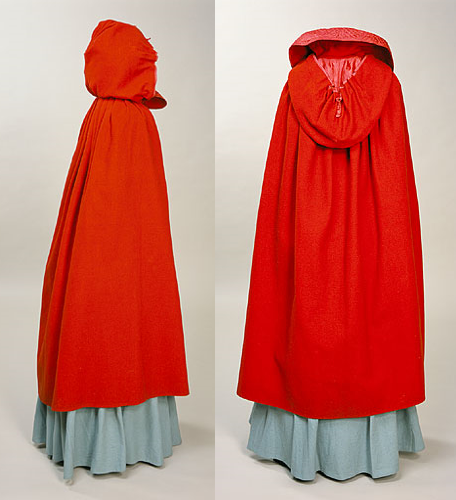
The cheapest option was a plain woollen shawl, crossed over the shoulders and tucked into a waistband or apron strings, often accompanied by a neckerchief tied as a headscarf, and a hat on top. The most fashionable option for the working woman, however, was the full length hooded cloak, almost always made of red wool (made famous by Little Red Riding Hood), as seen opposite. These can be bought from several traders, including Jas. Townsend, though are understandably pricey due to th amount of wool required.
In order to keep hands warm, gloves or muffs were not an option for working women, who instead wore items know then as ‘mufties’, which are happily still widely available, known today as fingerless mittens. Combine these with woollen stockings, and toiling out in the cold fields for hours on end might be slightly more bearable.
